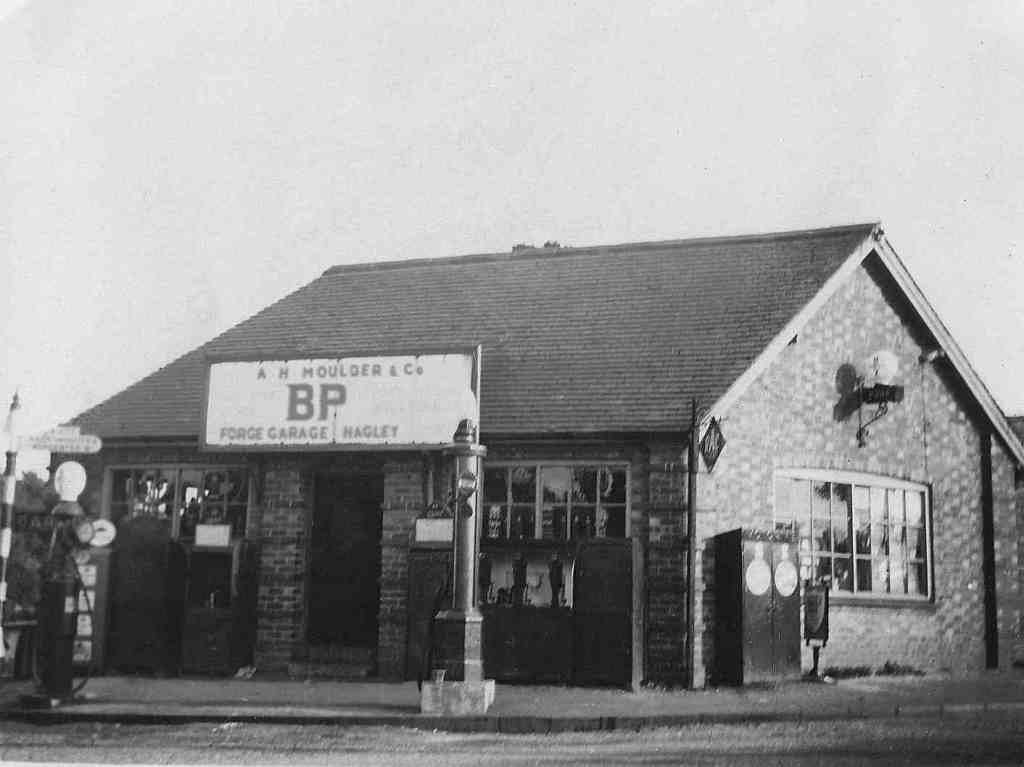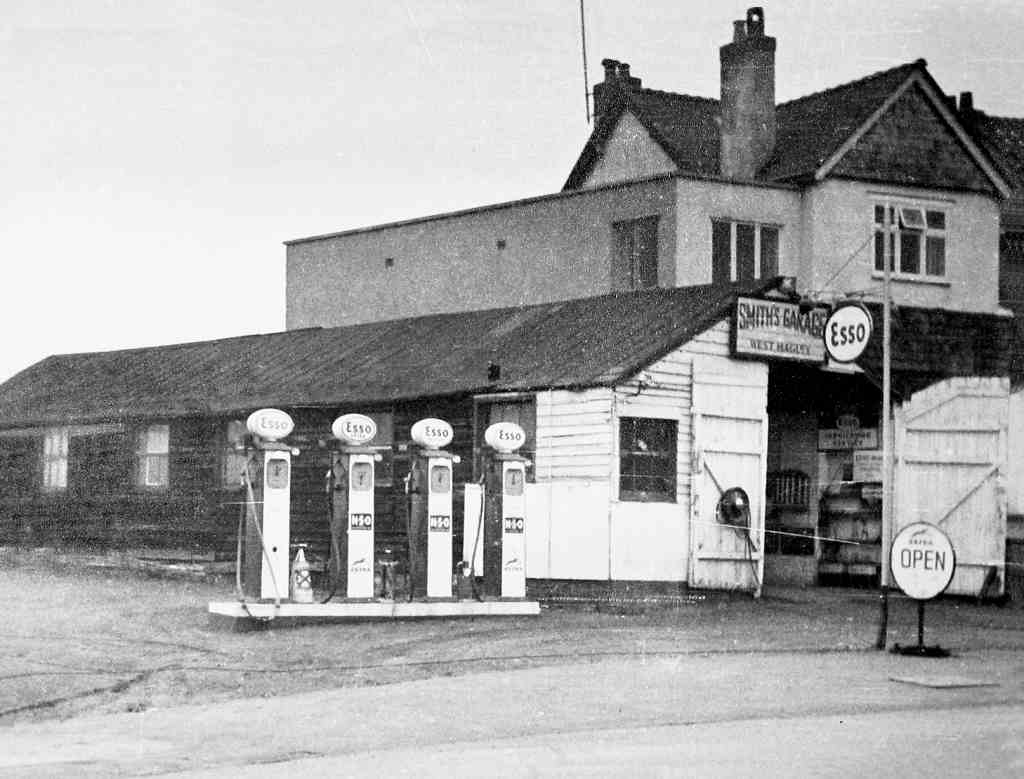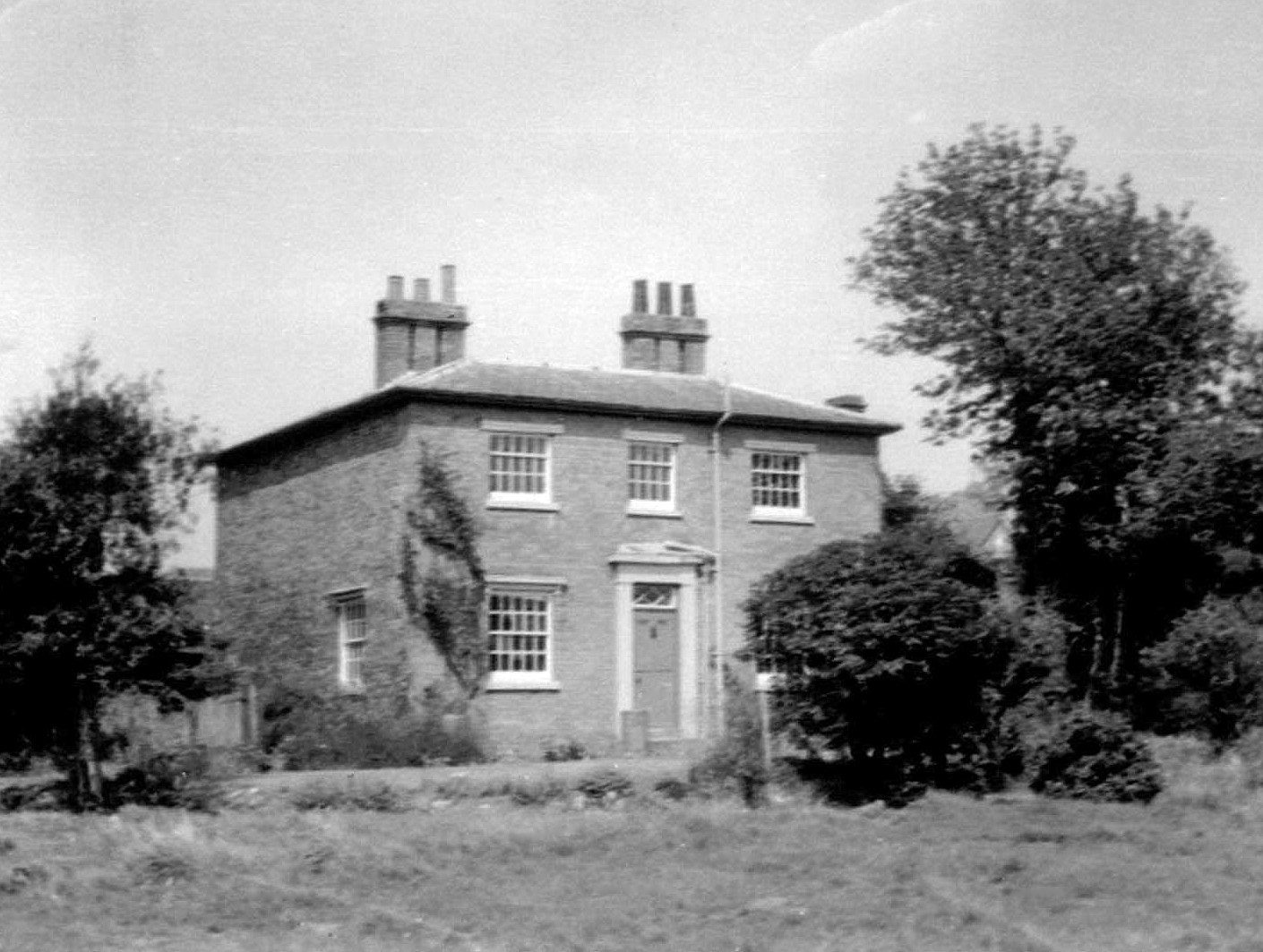Photographs
Garages of Hagley

Ben Cutler ran Central Garage from around 1920 to 1962 and it finally ceased trading in the 1970s. The grocer's shop on the right was run by Elizabeth Cutler. Note the petrol pump with boom across the road on this 1920s photograph. The cottages on the right are now Mercian Travel and Walton & Hipkiss, while the garage and the left hand of the picture are now part of Bakery Court.

This 1929 photograph shows the original Forge Garage built on the site of the old village forge at the junction of Kidderminster Road and Bromsgrove Road. During the Second World War the garage was rebuilt and enlarged so that it could take military vehicles if necessary.

This photograph of the post-War garage dates from the 1970s and shows that Shell petrol was sold, the garage was an agent for BMC cars and that credit cards were taken. The business changed from car repairs to new car sales in the 1990s and since then it has had many different vehicle franchises, but all have been luxury or sports models. The house to the right of the garage has since been demolished.

This 1960s photograph shows the small establishment on Worcester Road, not far from the Cross Keys. Smith’s ceased trading in the 1980s and the site became a used car business, specialising in executive and sports cars. The house to the right with its extension still stands adjacent to the present business.
Hagley Railway Station
Hagley Railway Station as it was in the days of steam

This view shows the crowds that were there to see Queen Elizabeth and Prince Philip when they visited Hagley in 1957. Current thinking on health and safety would prevent the mass trespass on railway land seen here! The sidings were taken up in the1960s. Note the coal merchants’ huts in the background.

This view of the station was taken in the early twentieth century. The large building on the right is a typical GWR late nineteenth century structure but the wooden building on the same platform is much older. The building on the other platform has now gone but it survived (without its canopy) until the 1980s. Notice the very tall signal by the signal box, positioned so that it could be seen over both bridges. The inhabitants of the village fought the GWR from 1875 until 1884 to get improved facilities until the rebuilt station and approach road opened later that year, jointly funded by both parties.

This photograph was taken on 15th July 1961 and shows 5095 Banbury Castle on a stopping train from Wolverhampton to Worcester. The signal box was opened, with others of similar design between Kidderminster and Rowley Regis, in 1887/8. The tiny goods yard on the left is seen with a solitary coal wagon, loading gauge, cattle dock and typical GWR pagoda roof corrugated iron hut: the prosaically titled The Sidings residential development now occupies the site.

Despite being awarded Grade 11 listed status in 2000, the footbridge is a standard Great Western Railway product, to be seen across that railway. The decorative ironwork includes its date of construction and of the rebuilding of the station, 1884, as well as interwoven letters ‘GWR’. The Hornby plastic model used the Hagley footbridge as its inspiration.
The Oxford, Worcester and Wolverhampton Railway opened its line from Droitwich to Stourbridge on 1st May 1852, but a station at Hagley did not appear in the timetable until ten years later. As can be seen by the unusually wide spacing between the tracks, the formation was made sufficiently wide to accommodate Brunel’s broad gauge track. Some sources claim that a single broad gauge train travelled the mixed gauge track through Hagley as far as Wolverhampton.
Old Houses of Hagley
Old Houses of Hagley which have all been demolished to make way for modern developments

This photograph shows the farmhouse of Green's Farm access to which was from Park Road. The housing estate that comprises Lodge Crescent was built on the site of the farm which was demolished in 1957.
The 1871 census was the first that identified a farm on this site. It was then occupied by John Taylor Birch and Nancy Birch both aged 48. They were still living there in 1901. Nancy Birch died in 1905 and John Taylor Birch died in 1906.
In 1911 the residents were Albert Sidney Green and Elizabeth F Green.

This photograph shows Hagley Grange that was located along the B4187 where the road of the same name is now.
Hugh Ernest Folkes aged 39 and May Isobel Folkes aged 30 lived there in 1911. Hugh was an architect and surveyor and had had it built in 1908. It was demolished in 2005 and a group of houses were built on the site.

This photograph shows Hagley House which was built in 1725 and was demolished in 1933. It stood on Birmingham Road, Hagley (A456). Its grounds were bordered by the east side of Stourbridge Road (A491). Milton Drive is now approximately where its driveway was.
The 1851 census shows that the residents were William Robins aged 62 and Christiana Robins aged 49. William was a banker and J.P.
It was known as Holly Grove in 1871 when Michael Phillips Grazebrook, ironmaster, and Mary Anne Grazebrook, both aged 48,lived there. They moved in in 1861 and stayed for 20 years.
In 1891 Charles Collis, aged 64, a County Court Registar, lived there.
In 1901 Joseph Moore, colliery proprietor aged 60, and Henrietta Moore, aged 52 were residents. Joseph died in December 1901. His widow contiued to live there and was followed by her son Howard. George Hatton lived there from 1912 when it was again known as Hagley House.

Rose Cottage is the double fronted building to the right of centre in the photograph. In the 1930s it was a tied cottage of the Prowse and Humphries butcher's business in the premises on the left of the photograph.
When Rose Cottage was demolished the Midland Bank, which later became HSBC, was built on the site at 115 Worcester Road. HSBC closed in 2012 and the premises became a kitchen shop.
The square stone gate post on the right of the photograph is still there today.

The house shown in this photograph is Winds Point which was built on Worcester Road for a local solicitor, Wickham King who, with his wife Beatrice Mary, moved in to it in 1906. It was demolished in 1964 and new houses were built on the site. It stood where the eastern end of the road with the same name is now.
Wickham King was also an amateur geologist, climber and treasurer of the Appeal Committee which raised funds to pay for the building, in 1907-08, of St. Saviour's Church in West Hagley.